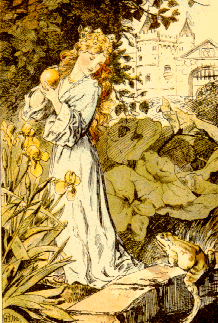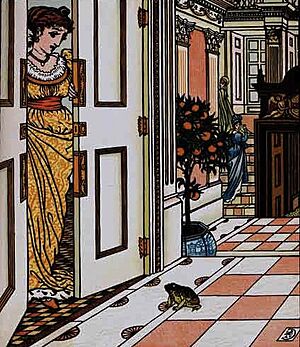The Frog Prince facts for kids
Quick facts for kids The Frog Prince |
|
|---|---|

The Frog Prince by Paul Friedrich Meyerheim (1889)
|
|
| Folk tale | |
| Name | The Frog Prince |
| Also known as | The Frog Prince; or, Iron Henry |
| Data | |
| Aarne–Thompson grouping | AT 440 ("The Frog King") |
| Region | Germany |
| Published in | Kinder- und Hausmärchen, by the Brothers Grimm (1812) |


"The Frog Prince; or, Iron Henry" (in German: Der Froschkönig oder der eiserne Heinrich) is a famous German fairy tale. The Brothers Grimm collected and published it in 1812 as part of their book, Grimms' Fairy Tales. It is usually the very first story in their collection. This type of story is known as Aarne-Thompson type 440.
Contents
How the Story Began
Different Versions
The most well-known version of "The Frog Prince" comes from the Brothers Grimm. They included it in their 1812 book, Kinder- und Hausmärchen, as story number 1. The Grimms really loved this tale. They thought it was one of the "oldest and most beautiful" stories from Germany.
The Grimms likely heard the story from Dortchen Wild's family in Kassel. An earlier, more serious version was in the Grimms' handwritten notes from 1810. In 1815, a slightly different version called Der Froschprinz (The Frog Prince) was published. However, this version is not as famous today.
Some experts believe parts of the story might be very old, possibly from Roman times. For example, in an old Roman book called Satyricon, a character says, "The man who was once a frog is now a king." This might have been a joke about Emperor Nero, who was sometimes compared to a frog.
Story Types
Folkorist Stith Thompson thought the German story of the Frog King started with a written tale from the 1200s. Stories like "The Frog Prince" are classified using the Aarne–Thompson–Uther Index. This system helps to group similar folk tales from around the world.
The Story's Plot
The tale begins with a princess who is a bit spoiled. One day, she is playing with her favorite golden ball near a pond. She accidentally drops the ball into the water. A frog appears and offers to get her ball back. In return, he asks for her friendship.
The princess agrees, but she doesn't really mean it. The frog retrieves her ball. He then follows her back to the castle and insists she keep her promise. The frog, who is under a witch's curse, needs help to become human again.
In the original Grimm version, the princess gets so annoyed that she throws the frog against a wall. This action breaks the spell, and he turns back into a handsome prince. In many modern versions, the princess kisses the frog, which then transforms him.
Some older versions of the story say the frog only needed to spend the night on the princess's pillow.
The story also features a loyal servant named Henry, sometimes called Iron Henry. Henry was so sad about his master's curse that he had three iron bands put around his heart. These bands were meant to keep his heart from breaking. When the frog prince turns back into a human, Henry is so happy that all three iron bands break off his heart.
Similar Stories
"The Frog Prince" is a type 440 story in the Aarne–Thompson–Uther Index. Many other folk tales share similar themes:
- "The Wonderful Frog" from Hungary.
- "The Tale of the Queen Who Sought a Drink From a Certain Well" from Scotland.
- "The Well of the World's End".
- "The Maiden and the Frog" from England.
- "Oda and the Snake" from Germany, where a snake takes the place of the frog.
- "A Frog for a Husband" from Korea.
Another similar story type is ATU 402, called "The Animal Bride." In these tales, a female animal, like a mouse, cat, or frog, helps a prince. After they marry, she turns into a human. In stories like Puddocky (a German tale) and The Frog Princess (a Russian tale), the frog is a female character. For example, Prince Ivan Tsarevitch finds an enchanted female frog who becomes a wise sorceress.
An ancient Greek story about Amymone might also be similar. She was trying to get water during a drought. A satyr tried to harm her, but the god Poseidon saved her. Some think the frog suitor and the prince might have been separate characters in very old versions of the story.
The Story's Impact
"The Frog Prince" has inspired many plays, movies, and books over the years.
- In 1896, Adelheid Wette wrote a play based on the story called "The Frog King."
- The Frog (1908) was one of the first film versions, directed by Segundo de Chomón.
- Stevie Smith wrote a poem called "The Frog Prince" in 1966. It imagines what the prince might be thinking while waiting to be human again.
- The Frog Prince was a 1971 movie starring Kermit the Frog.
- Anne Sexton included her own version of the poem in her 1971 book Transformations.
- The Door in the Hedge (1981) by Robin McKinley has a version called "The Princess and the Frog."
- The story was featured in Faerie Tale Theatre in 1982, with Robin Williams as the Frog Prince.
- The Frog Prince is a 1986 film.
- In Shrek 2, Fiona's father, King Harold, is secretly the frog prince.
- A musical version of The Frog Prince was performed in Germany in 2005.
- The Princess and the Frog, a 2009 Disney animated film, is loosely based on a novel called The Frog Princess. In this movie, the kiss turns the princess into a frog too!
- The video game series Dark Parables used the tale for its second game, The Exiled Prince.
- The band Keane released a song called "The Frog Prince" in 2004.
|
See also
 In Spanish: El príncipe rana para niños
In Spanish: El príncipe rana para niños

